How To Care For Asparagus Fern – Indoor Asparagus Fern Care
Asparagus fern thrives indoor in sturdy pots in cooler climates in good amount of indirect sun. They are not very choosy when it comes to soil and fertilizers. Just water them when the top soil feels dry.
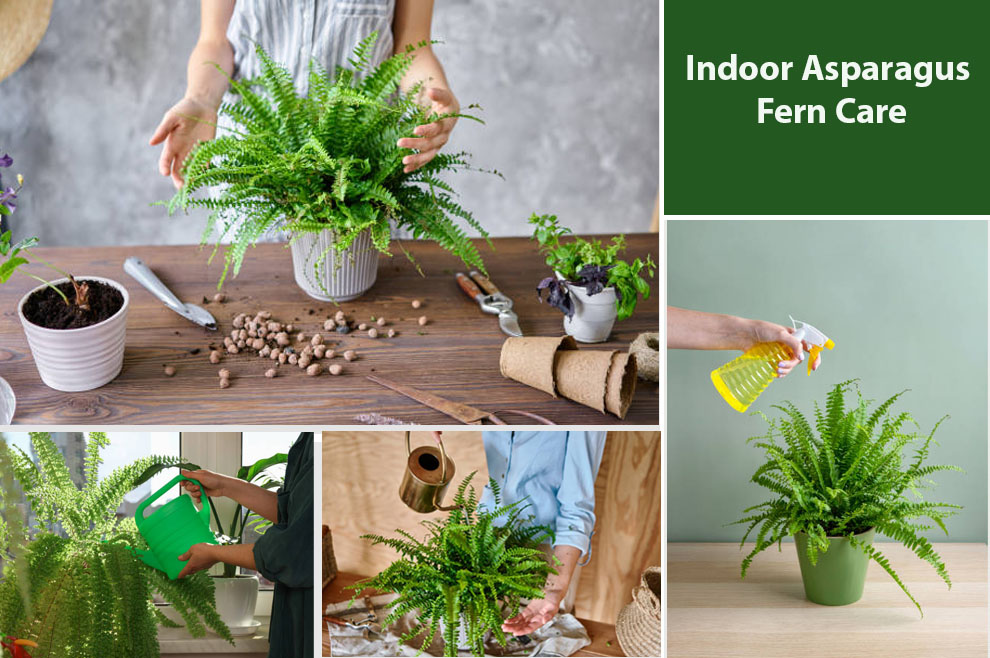
The asparagus fern plant is a versatile herbaceous perennial plant. Typically bound in a hanging basket, people employ it to decorate their patio or deck in the summer.
Asparagus ferns make for one of the best houseplants. But, for them to survive, you must be well-versed in indoor asparagus fern care.
A happy asparagus fern yields small white flowers followed by red berries that attract birds. However, most home gardeners grow it for its foliage.
Indoors, foxtail ferns should be planted in a sturdy pot in a regular indoor potting mix. They prefer cooler temperatures but not too cold with decent humidity levels. A good amount of watering and water-soluble fertilizer is also needed by these plants. If growing asparagus ferns outdoors, you should place them in a spot that receives partial sun in a shady location.
While handling the asparagus ferns, you must be cautious as the tiny thorns along the stem’s length may scratch. Hence, experts recommend not touching the plant too much as it might result in brown leaves. Moreover, most parts of asparagus ferns are toxic to pets and humans.
They look equally appealing when grouped along with the other plants, especially ones with contrasting leaf shapes. It also does a fine job of purifying the indoor air.
They have delicate and airy foliage that resembles the asparagus leaves, but it gracefully arches like a fern. Hence, giving it the name asparagus fern. But it is not a fern. Instead, it is a member of the Liliaceae family belonging to Southern Africa’s humid forests.
How To Take Care Of Asparagus Fern Indoors?
People who live in USDA hardiness zone nine or warmer can grow asparagus fern outdoors as a perennial. Indoors the plants cherish high humidity, cooler temperatures, regular watering, and indoor potting soil mix.
Even though the ferns may look soft, they are pretty sharp. So, consider wearing gloves if you intend to prune an overgrown or older plant. When the plant is grown in a suitable climate, and you offer it the necessary care, it yields berries.
A. Container Size
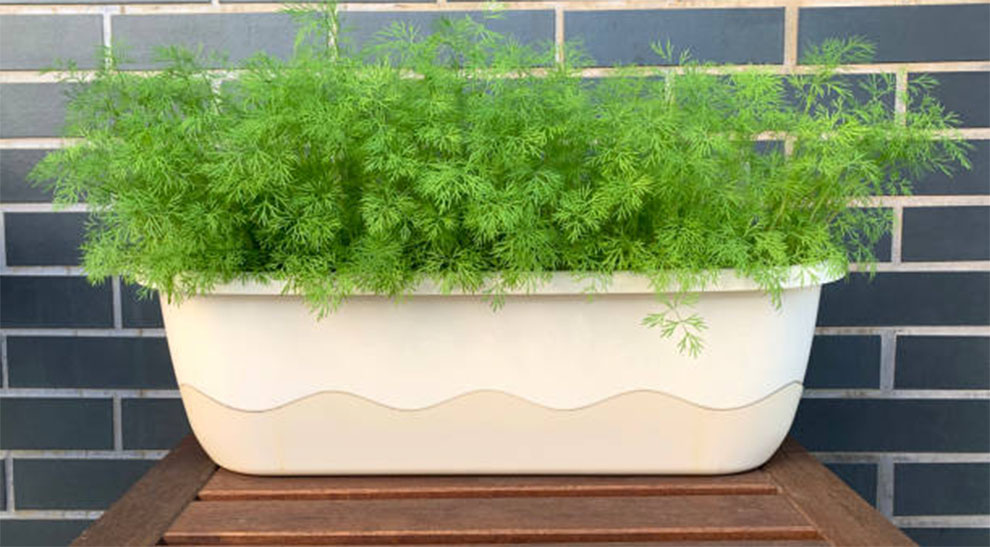
For container asparagus fern gardening, pick a sturdy pot because its root system is vigorous. So, if the container is not sturdy or you opt for a plastic pot, the roots might burst right through it.
In addition, ensure that the container is large enough to accommodate the plant’s width as it matures.
Alternatively, you can start with a smaller pot and then graduate to a larger one as and when needed. Whichever pot you pick, ensure that it has ample drainage holes. You must consider repotting the plant whenever the asparagus fern roots run out of space.
B. Light
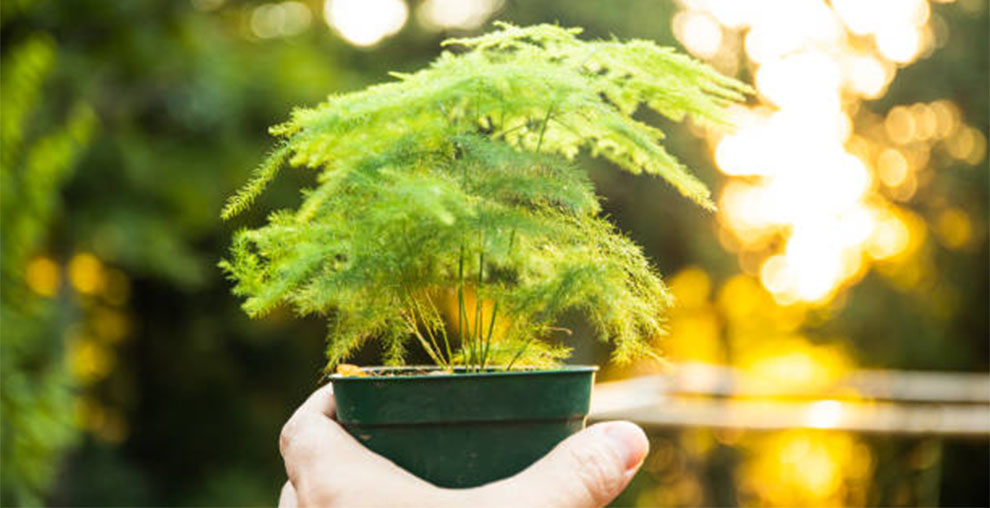
Asparagus ferns demand some light. Hence, do not hide them in dark corners. If you ensure that the plant has access to indirect, medium-dappled light, it will bring out the best in your asparagus plants.
However, the plant should not be exposed to direct sunlight in the summer, especially when the sun’s rays are sharp. But please note the lesser light the ferns receive, the more gradual the growth.
You must immediately move your plant to a brighter spot if that happens. Hence, light is an essential prerequisite for asparagus fern care.
C. Temperature
How to care for an asparagus fern indoors if you live in a hot climatic zone. Fortunately, asparagus ferns are versatile. So they will adapt to most household conditions. However, they enjoy the cooler temperatures the most but can also tolerate the temperature in the 90s.
If the heat wave is intense, you can add water or move the plant to shade. But, when the temperatures are stagnant and hot, you should opt for a fan that offers good air circulation. Good air circulation helps keep diseases, fungi, and pests at bay.
D. How often do you water an indoor asparagus fern?
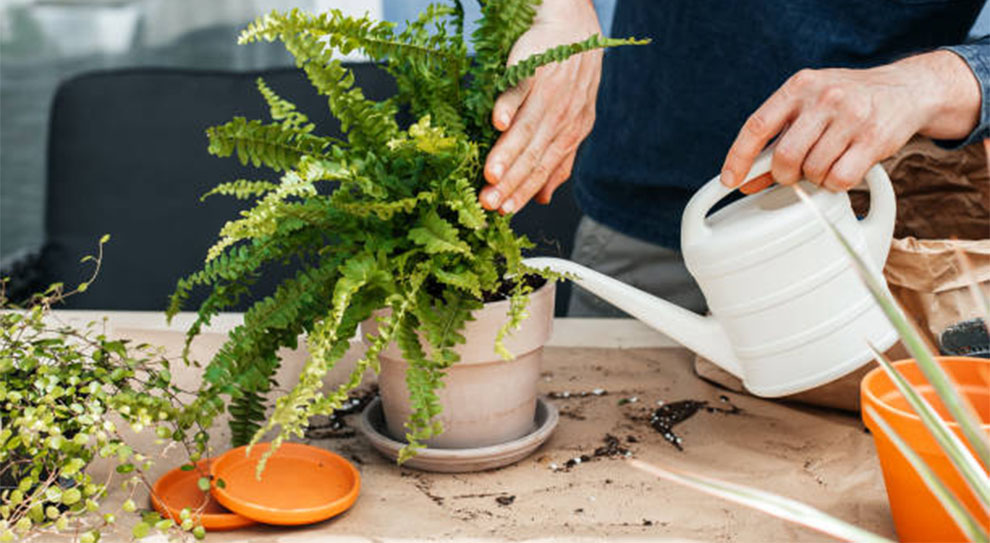
Typically, an asparagus fern is a thirty plant. So, you will have to water it more frequently than your other plants.
You must assess the plant’s topsoil instead of having a fixed watering schedule. If it feels dry, you must water the soil thoroughly, ensuring it is moist but not soggy. Further, to ensure your ferns do not swim in the water or there is a pool of water around, you must ensure that the pot has drainage holes that do not let the water sit.
But how to care for asparagus fern indoors If you notice brown fronds? It is a giveaway sign of underwatering. Hence, consider increasing the watering frequency. Please note that you must check your ferns more frequently than other plants till you know the plant’s watering schedule. Typically, watering once a week suffices, but if the weather is hot or you live in areas with drier air and a hotter climate, you must water more frequently.
E. Humidity
Asparagus ferns grow best in tropical rain forests. Hence, a certain amount of humidity is imperative to ensure that your asparagus plants are vigorous and strong.
If the humidity is poor anytime, you can reach out to a humidifier that can help increase the humidity around the house in the colder months when the forced air heat is cranking, resulting in dry air. Regular misting can also help with humidity.
F. Soil

Planting the asparagus fern in the proper soil is a pivotal aspect of indoor asparagus fern care. Fortunately, the plant is not very picky about the soil. Hence, any standard indoor potting mix should do the trick.
But you can add vermiculite or perlite into the soil to aerate it and offer additional drainage. In well-draining soil, you might want to frequently water the plant. Fortunately, the plant also does well in loam soil – an amalgam of clay, silt, and sand.
Every year in spring, you must change the soil to provide it with a fresh dose of nutrients. Fertilizing during growing can also help.
G. Fertilizer
Consider fertilizing the asparagus fern with an all-purpose or water-soluble fertilizer. Dilute the fertilizer to fifty percent of its strength. During the growing season from March to August, you must fertilize once every three to four weeks.
After that, fertilizing only once every month suffices. You can opt for a balanced fertilizer or a higher nitrogen ratio feed to make up for the soil deficiencies.
Please note that water-soluble fertilizers come in powder or liquid form, but if it is a powder fertilizer, you mix it with water. You can use the hose-end sprayer or a watering can to feed the fertilizer. Ensure you pour the fertilizer till the soil is saturated but not drowning in water.
H. Asparagus fern pruning – Should I cut off the brown leaves of the asparagus fern?
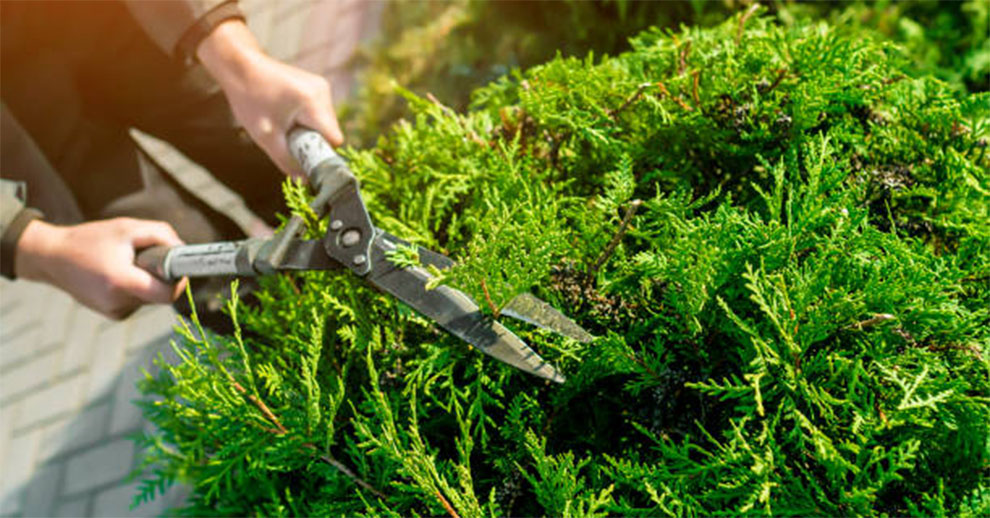
Asparagus fern is a fast grower. Consequently, it might look unappealing if you do not trim and tidy it up. Of course, it is okay if you like your plant to look shabby and wild. But pruning adds to the plant’s visual appeal and triggers new growth.
Ideally, prune the older stems every spring. Dead or old stems will look withered and dry and not yield any fresh produce. In addition, you must also trim the growth or stems that stick out excessively or appear dead or dry.
Chopping mushy, soft, or brown leaves and roots helps confirm that the plant does not waste any vital energy trying to keep the leaves and roots alive. By getting rid of these from the plant, you ensure that the asparagus fern directs all its energy into growing healthy and new green growth.
While pruning, you must wear gloves to avoid getting scratched by the needles on the fern. You can use hand pruners or scissors to prune any extra growth. Ensure that they are clean and well-sanitized.
Further, cut at the base, not from the middle. Once pruned, the plant will yield red berries and white flowers. The red berries accompanying the blooms are poisonous. Hence, never eat them.
I. How to overwinter asparagus fern?
If the temperature in your geography is below fifty-five degrees Fahrenheit, you must move the asparagus ferns in the pots to a spot that receives bright light indoors.
In addition, you must also keep them away from heat or drafts. Further, water is only enough to keep the soil moist. If there is water pooling around the asparagus, it might result in root rotting.
In spring, when the temperature is at least sixty degrees, you can move the containers outdoors in a protected area for some weeks and finally to their permanent location.
Related: Types of Asparagus | Foxtail Fern Care
Pests and Diseases
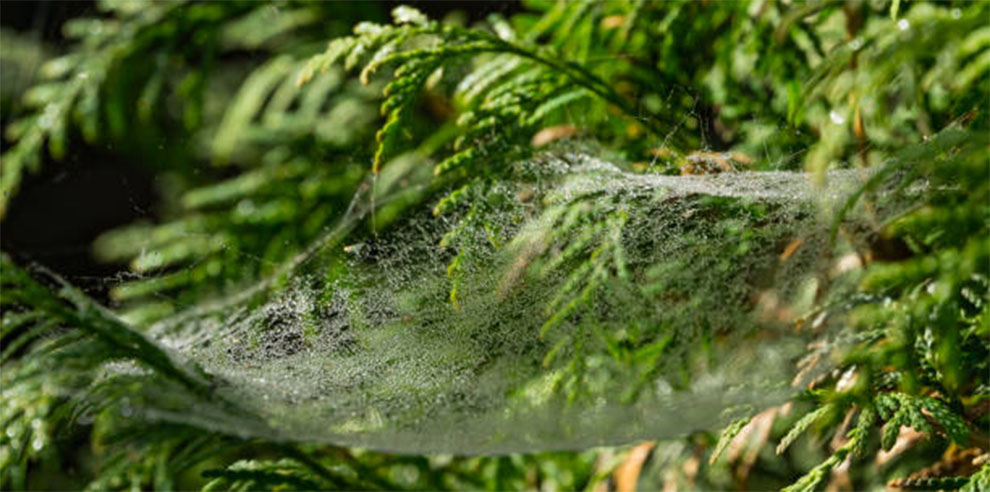
Taking measures to keep pests and diseases at bay is crucial in indoor asparagus fern care. Fortunately, barring temperature extremes, with the correct water and lighting, you can ensure that your plant is susceptible to minimum pest and disease issues.
However, stress from overwatering or underwatering can be a breeding growth for spider mites, mealybugs, whiteflies, and aphids. When these pests infest the plant, you must immediately use neem oil or insecticidal soap. If that does not work, hard pruning and light fertilizing can also give your plant a fresh start.
Further, asparagus ferns might also attract slugs in humid conditions. Thus, avoid excess moisture by employing methods like barriers, bait, and traps.
Beyond pests, some fungal diseases too might infect the plant if the soil is overly wet, such as root rot, leaf spot, and crown rot. Reducing the plant’s watering frequency and using a fungicide can help tackle these concerns.
Related: Indoor water plants
Frequently Asked Questions
Ques 1. What is the difference between foxtail fern and asparagus fern?
Ans.
- Typically, the foxtail ferns grow in vast clusters of large plumes and delicate leaves. However, the other types of asparagus ferns grow lower to the ground.
- The foxtail ferns will yield smaller white blooms that later become red berries, but not every asparagus fern does that.
- Foxtail palm is an excellent outdoor container or a houseplant, given its plume-like and tall foliage. It is not suitable for ground cover like the other varieties but can be a good statement plant. On the contrary, other asparagus ferns are found in containers or used as ground covers for their delicate flowers and appearance. Since they are an invasive species, you must take active measures towards their maintenance.
- Foxtail ferns grow in USDA hardiness zones nine through eleven, but most asparagus ferns grow best in USDA hardiness zones seven through eleven, depending on the species.
- Foxtail ferns thrive in partial shade and morning sunshine. You can also keep them indoors where they receive indirect sunlight. Other asparagus fern varieties cherish indirect, bright sun with daily misting. Some asparagus ferns are more drought-tolerant than others. Hence, water when the topsoil feels dry.
Ques 2. Is asparagus fern toxic?
Ans. Yes, it is toxic for both humans and pets.
Ques 3. How do I make my asparagus fern green again?
Ans. Underwatering and low humidity are the two plausible causes of leaves looking dull and brown. So, indoor asparagus fern care requires daily misting and watering whenever the topsoil feels dry. It can help make the asparagus fern green again.
